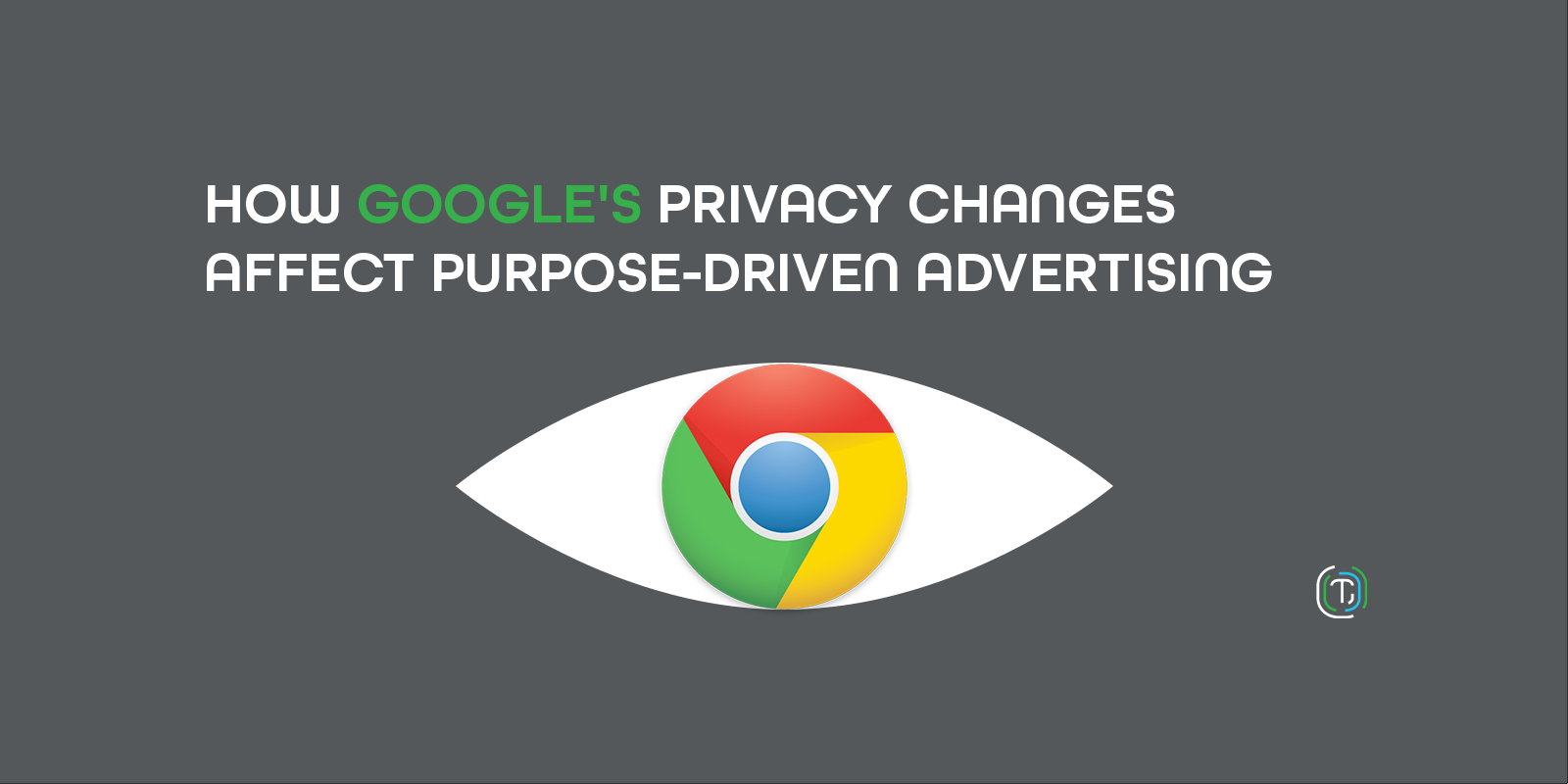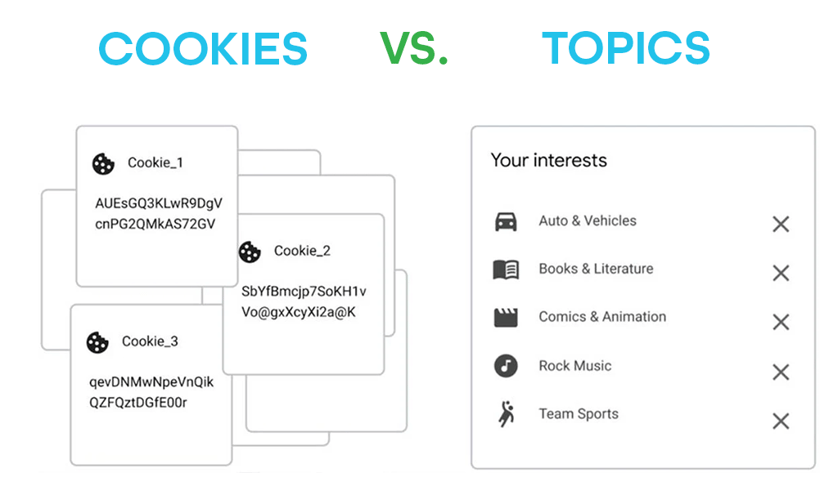Topics Replaces FLoC

There have been so many privacy updates and changes to data regulations that it can be hard to keep track of it all. One of the companies that has been making what seems like constant changes? Google. The tech giant recently announced that it would be rolling back FLoC. This announcement confused many advertisers because not many people were aware of FLoC or what it was.
This confusion could lead to a major problem for purpose-driven advertisers because Google’s announcement will affect how advertisers can collect and track data.
In this article, we will go over:
- What was Google’s latest announcement about data privacy?
- What is FLoC?
- What is the Topics API?
- What does this change mean for purpose-driven advertisers?
- How do advertisers move forward?
Breaking down Google’s announcement about their data privacy changes
On January 25th, 2022 Google announced that they were going to be rolling back their FLoC proposal and replacing it with something called Topics - “a new Privacy Sandbox proposal for interest-based advertising.”
So what was FLoC?
FLoC stands for Federated Learning of Cohorts (FLoC). Google’s proposed FLoC enabled “interest-based advertising on the web” without letting advertisers know your identity. Instead, you were associated with a “cohort,” a group of users sufficiently large enough (thousands of users) to make you at least semi-anonymous to the companies targeting you.
Under FLoC, Google would tell the website that a visitor is a part of cohort 123456. However, Google would not tell the website (or advertiser) what cohort 123456 was interested in - figuring that out would be on the ad tech industry.
FLoC was Google’s original proposed solution to getting rid of third-party cookies in their browser Google Chrome. This was a big deal for Google because they could not deal a huge blow to the online ad industry by simply getting rid of third-party cookies - that is how Google makes money.
Here is what Google said about its’ now-defunct alternative to third-party cookies:
"When other browsers started blocking third-party cookies by default, we were excited about the direction, but worried about the immediate impact. Excited because we absolutely need a more private web, and we know third-party cookies aren’t the long-term answer. Worried because today many publishers rely on cookie-based advertising to support their content efforts, and we had seen that cookie blocking was already spawning privacy-invasive workarounds (such as fingerprinting) that were even worse for user privacy. Overall, we felt that blocking third-party cookies outright without viable alternatives for the ecosystem was irresponsible, and even harmful, to the free and open web we all enjoy. "
-Marshall Vale, Google Product Manager, Privacy Sandbox
What was wrong with FLoC?
FLoC had 99 problems and data privacy was all of them. The concept of FLoC was well-intentioned but once Google introduced the concept, the privacy-protecting technology actually was going to lead to more privacy risks.
The Biggest FLoC Data Privacy Risk: Fingerprinting
FLoC’s most glaring issue was that it allowed for fingerprinting.
What is fingerprinting?
Fingerprinting is when someone is able to gather many discrete pieces of information from a user’s browser to create a unique, stable identifier for that browser - similar to a virtual fingerprint. This practice essentially circumnavigates the individual privacy component of FLoC.
FLoC would have given fingerprinters a huge advantage because instead of trying to identify an individual out of the billions of people on the web - they only have to distinguish you from a few thousand.
Many privacy advocates voiced that Google should not create new fingerprinting risks without figuring out how to deal with the fingerprinting risks that already exist.
Another FLoC Data Privacy Risk: Cross-context Exposure
The other glaring problem with FLoC is that it will share new personal data with trackers who can already identify the users.
What does that mean?
FLoC would not disclose individuals in cohorts directly. However, the big loophole is that if a site knows an individual's PII (for example their email address) could record and reveal an individuals’ cohort.
To put this in perspective: if your website offers a login option such as “login with Google” you would be able to tie the information you learn from FLoC to the user’s profile. This renders the “anonymous” aspect of FLoC relatively useless because it reveals two categories of information:
- Specific information about browsing history
- General information about demographics or interests
It became glaringly clear to Google that FLoC was a flop so, they replaced FLoC with Topics.
But, is Topics really any better?
What is Google’s Topics?
Topics is a new Privacy Sandbox proposal, by Google, for interest-based advertising. According to Google, Topics allows your browser to determine a handful of topics based on your browsing history for that week to represent you. These topics can range from things such as “Fitness” or “Travel & Transportation” but will exclude sensitive topics such as “race” or “gender” according to the tech giant. Google also stated that topics are kept for only three weeks and old topics are deleted.

Under Topics, when a user visits a participating website, Topics selects just three topics (one from each of the past three weeks) to share with the site and its advertising partners.
The big privacy news that Google is boasting:
“Topics enables browsers to give you meaningful transparency and control over this data, and in Chrome, we’re building user controls that let you see the topics, remove any you don’t like or disable the feature completely.”
They also claim Topics circumnavigates browser fingerprinting while still being able to serve users relevant ads.
What does Google’s Topics mean for purpose-driven advertisers?
This announcement is similar to Meta’s Ad Ban Announcement in the sense that Topics is not the end of the world for advertisers. They just need to read between the lines.
The key takeaway from Google’s announcement is this:
Topics really only affects you if you rely on third-party cookies (or FLoC) for targeted advertising.
However, be cautious about relying on Topics for targeted advertising.
Why?
Google said Topics would exclude “sensitive topics.” This choice of words is a very grey, subjective area. On Google’s blog, they only gave two examples of “sensitive topics”:
- Gender
- Race
They did not say those were the only two things considered sensitive. Also, there was nothing saying they would not classify more things as sensitive in the future. This is the approach Meta took on their platform and it severely impacted many purpose-driven advertisers on their platform by restricting what topics advertisers could target around.
An Audience Targeting Solution for Purpose-Driven Marketing to Navigate Google’s Topics
To be clear, you can still target your advertisements on Google. However, you will not be able to extract the same information from Google that you used to be able to.
The next question you might ask is, “Well if I can no longer get detailed information about your audience from Google, where can I get it from?”
Truthfully, you can get data about your audience from many different agencies or data intelligence companies like Tunnl.
At Tunnl, we’ve been building audiences in a privacy-compliant way for over 20 years and house over 100,000,000,000+ data points. In fact, last year we generated more than 60,000,000,000+ audience data points for our clients.
Explore and Activate Tunnl Audiences
At Tunnl, we offer two different kinds of audiences - custom and pre-built. Our 150+ pre-built audiences are a great solution for those with quick turnaround times or tighter budget constraints. Our custom audience solutions are a great fit for those with niche issues or a unique geography.
Before you embark on a custom audience project, be sure to check out our pre-built audience library to make sure we have not already covered your advocacy issue. If we have, you could save time and money!
To learn more about our audiences or how to activate them, contact Nate Romberg, Tunnl’s Senior Director of Partnership Sales. You can reach Nate at 562-852-3800 or nromberg@tunnldata.com.
Keep Learning About Tunnl
Tunnl exists to create and connect customers with the audiences that matter most. We create the powerful link between brands and issues, melding cause and believer. Our drive and relentless focus on always digging deeper to identify, create, and connect with the right audiences is unmatched.
As more consumers turn to brands to solve social issues in the world around them, the expectation and responsibility placed on corporations continues to increase. We provide deeper, richer data through an easily integrated platform to get you the precise results you need to take action.
Custom and pre-built audiences are not the only audience solution products we offer at Tunnl. We also help connect you to your target audience by utilizing our Partnerships and Linear Optimization product. You can measure the impact on your audience with our Paid and Earned Media solutions.
Keep reading to learn more about what Tunnl does!

